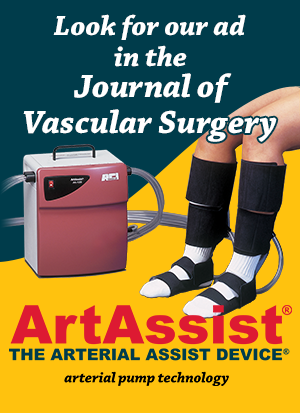There are two main mechanisms by which the ArtAssist® device improves blood flow: hemodynamic & hematologic.
Hemodynamic
First, the foot, ankle and calf veins are almost completely emptied in the sitting position by using pressures that are over twice those  typically used in deep venous thrombosis and lymphedema compression devices. By compressing all the tissues below the knee, a large volume of venous blood is emptied with venous pressure dropping to nearly zero. Device pressures are below arterial pressure so arterial pressures are unaffected. The increased arterial-venous pressure gradient results in greater arterial flow (Flow=Pressure Gradient/Resistance)
typically used in deep venous thrombosis and lymphedema compression devices. By compressing all the tissues below the knee, a large volume of venous blood is emptied with venous pressure dropping to nearly zero. Device pressures are below arterial pressure so arterial pressures are unaffected. The increased arterial-venous pressure gradient results in greater arterial flow (Flow=Pressure Gradient/Resistance)

Increases Blood Flow in Popliteal Artery: Superficial femoral artery occlusions

Intermittent claudication
 Hematologic
Hematologic

Click to enlarge
The increased pressure gradient alone does not account for the large blood flow increases seen with the ArtAssist® device.
A second mechanism for action involves the endothelium, the cellular lining of all vessels. This structure is recently seen as playing an important role in controlling peripheral resistance. Endothelial cells are known to release substances, including nitric oxide (NO) and tissue factor pathway inhibitor (TFPI), which act as vasodilators and anticoagulants. These substances are released in amounts corresponding to the shear rate of blood along the vessel’s endothelial surface.
The very rapid increase and decrease of the ArtAssist® device’s compression creates high shear rates intended to stimulate endothelial release of these and other important biochemical factors and stimulates collateral formation referred to as arteriogenesis.
Higher blood shear rates and associated pulsatile flows prevent and reduce platelet and macrophage adhesion to endothelial surfaces, which otherwise cause an inflammatory reaction that furthers endothelial dysfunction. The endothelial layer then becomes a barrier to the transport of metabolic products to and from the surrounding tissues, creating a so-called “microvascular steel.” Tissue plasminogen activator (tPA), a powerful endogenous thrombolytic agent, is produced by the endothelium but in greatly reduced amounts when pulsatile flow ceases.
It is well known that arteriopaths loose precapillary vasomotor control – pulsatile flow is thought to restore it. Also, proper vascular distribution within tissues is known to be based upon flow rates and associated shear stress (pulsatility).
Over long periods of time (several months), shear stress induced by the ArtAssist® device may cause proper redistribution or “remodeling” of the microvascular network. This is why ulcers are healed with the ArtAssist® device and remain healed after the device therapy is stopped.
Doppler Imaging
The ArtAssist® device increases popliteal artery blood flow in arteriopathic patients by 3.1 times, shown using duplex ultrasonic imaging. The images below show pre-compression and post-compression velocities on a patient with Femoropopliteal disease.













